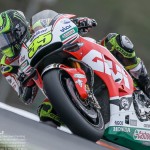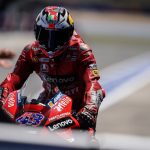Aragon was quite a weekend for Danilo Petrucci. Aside from revealing he and teammate Scott Redding are currently locked in an intra-team championship to receive a full factory GP17, and then causing that same teammate to fall in the race, incurring a ride through penalty, the Italian’s usual cheery demeanour wasn’t evident on Saturday. Instead Petrucci’s brow was furrowed in concern.
That morning he was the unfortunate victim of Pol Espargaro’s crash at turn two. As the Italian exited pit lane, he was unaware of an errant satellite Yamaha M1 careering in his direction. The resulting collision caused him to fall with some force.
“I was conscious,” he said of his first thoughts after the crash. “But I didn’t remember where I was. I said, ‘OK, my bones are all together,’ so I came back to the pits. But when I went back out I didn’t remember where I was. I was quite scared.”
Speaking the following day, he expanded on those laps at the end of the session, when along with pushing for a top-ten lap time, he found himself wondering in which way the track was headed. “It was quite strange to be on the bike, after two days at the same track, and not remember which corner I was at,” he said.
For a sport that stresses the importance of ‘matter’ operating north of the eyebrows, Petrucci’s words were, at best, worrying. His admission that he was failing to piece his memory from certain points that morning suggested he was suffering from some form of concussion.
How then was he cleared to complete six further flying laps in that same session? At that point Petrucci was not only placing anyone with whom he was sharing the track at risk, the potential implications of the Italian falling again that morning, or indeed, that weekend don’t bear thinking of.
Concussion and then continuing as normal has known side effects, with nausea, headaches and fatigue common complaints. But twice can lead to serious consequences. Second-impact syndrome occurs when a second concussion is sustained before the effects of the first have diminished. The brain can swell rapidly – a potentially fatal occurrence.
So was this a case of negligence on the part of doctors at hand? In defence of those medical officials responsible for Petrucci after this incident – Dorna’s medical team, doctors from the circuit medical centre – the Pramac man was ably darting through the gravel trap soon after the incident.
Indeed a glance at Petrucci’s pace in that same session after his tip off do not point to a rider hazily questioning his own whereabouts, much in the manner of a booze-addled pensioner, found outside his local, sodden with drink at 3am on a Sunday morning. Far from it. Of the six flying laps he completed, only one was in excess of six tenths than his fastest time.
Race director Mike Webb was also convinced he had received the correct medical care in the wake of his spill. “The CMO, the chief medical officer and the medical director and race control are super strict every incident during practice and in race obviously,” he said after race day at Aragon was completed.
“They review the video immediately to see what happened to the rider. Did he strike anything? Was it powerful? Did he just slide? Any doubt whatsoever, that rider is obliged to be taken directly to the medical centre for a check-up, the neurological checks before he’s let back on the bike again.”
Yet one is left to wonder how Petrucci – visibly dazed when his helmet was removed in the Pramac garage – was allowed to exit pit lane so soon after the incident itself.
MotoGP introduced the SCAT3 assessment tool ahead of the 2015 season, following the lead of other motorsports, such as NASCAR. Used by medical professionals to probe if athletes are showing any clear signs of concussion, the checklist states: “if any of the following signs are observed … the athlete should stop participation … and not be permitted to return to sport the same day if a concussion is suspected.” Those signs include ‘Disorientation or confusion’, ‘Loss of memory’ and wearing a ‘Blank or vacant look’.
According to a person with access to the garage that shall remain unnamed, it was clear from basic observation that the Italian was not fully compos mentis. Supposedly Petrucci was not even completely sure of the identity of the person on-screen when it was transmitting live pictures of himself.
If Petrucci had been properly assessed – yet slipped through the net – it begs the question: does a more thorough kind of test need to be implemented? Webb insists the current procedure is rigorous to the point of inciting hostility. “[The checks are] super strict. The riders get pissed off because they’ve been marched off to the medical centre often with nothing wrong. But they err on the side of caution.”
In football for instance, a recent ruling ensured an independent doctor is onsite at Premier League matches to assist club doctors in diagnosing potential signs of concussion. Does MotoGP need to employ a further specialist to conduct further checks on injured riders? Or perhaps they should insist any rider with scratches on his or her helmet is forced to sit out a certain amount of time – or indeed an entire session until a correct prognosis is formed.
It’s worth noting the medical team did correctly judge Stefan Bradl to have received concussion in a morning warm-up incident at his home grand prix just three months ago. Yet how Petrucci was allowed to compete so soon after the incident needs to be reviewed. That it came during a weekend in which Niccolò Bulega was fined for making an ‘inappropriate’ gesture – nothing more than the showing of his middle finger – left one questioning whether the line between what matters most and least to most sensible heads in the sport had – like Petrucci’s memory – become slightly blurred.
Photo by CormacGP








